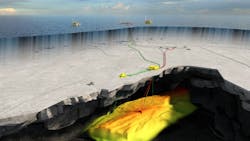Trestakk oil field on Haltenbanken in the Norwegian Sea came on stream July 16, announced Equinor Energy AS, the operator, which estimates Trestakk’s resources at 76 million bbl of oil. The subsea development is tied back to the Asgard A floating production vessel.
Initial production is about 22,000 b/d with peak production expected at about 44,000 b/d. Trestakk field production is expected to last for 12 years.
Discovered in 1986 by then Statoil’s ASA 6406/3-2 well, Trestakk lies in 300 m of water just south of Asgard. The discovery was delineated by well 6406/3-4 and identified oil in Middle Jurassic sandstones in the Garn formation.
The top of the reservoir lies at a depth of 3,885 m, and it was deposited in a shallow marine environment with calcite cemented intervals (OGJ Online, Nov. 1, 2016).
The development involves a subsea template with four well slots and one satellite well. Plans call for three production wells and two gas injection wells to be drilled. Asgard A floating production vessel was modified to receive production from Trestakk.
“Together with our partners ExxonMobil and Var Energi, we spent ample time on maturing Trestakk,” said Anders Opedal, executive vice-president for Equinor technology, projects, and drilling. The project involved numerous high-pressure, high-temperature systems.
Working with contractor TechnipFMC, Opedal said the partners “arrived at a good and profitable concept with development costs nearly halved before the investment decision was made. This proves that it is important and correct to spend sufficient time in the early phase of a project.”
The project was completed on schedule and below budget. When approved in 2017, the cost was estimated at 5.5 billion kroner, but final costs are anticipated to be 5 billion kroner, Equinor said.
The Petroleum Safety Authority Norway and the Norwegian Petroleum Directorate has approved applsications for extending the life time of the installation to 2031.
